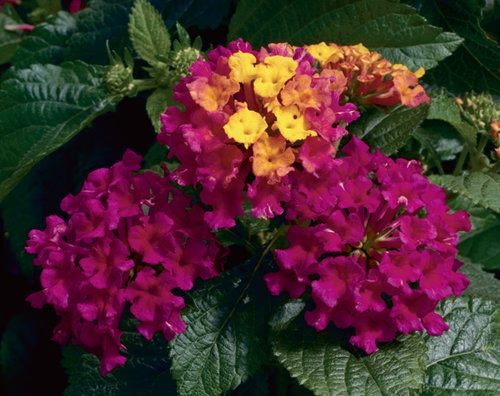
Cherry Lantana
Botanical Name
:
Lantana camara ‘Cherry’
Plant Type
:
Tender perennial (grown as an annual in colder climates)
Seasons
:
Spring, Summer, Autumn
Sun Level
:
Full sun (6+ hours of direct sunlight)
Ideal Soil Temperature for Planting
:
65–80°F (18–27°C)
Soil Type
:
Well-draining soil and tolerates sandy, loamy, and clay soils.
Germination
:
Usually propagated through cuttings rather than seeds. Seeds can take 1–2 months to germinate, while cuttings develop roots in 3–4 weeks, making them the preferred method for quicker growth.
P.H. Level
:
6.0– 7.5
Water/Irrigation
:
Drought-tolerant once established; water deeply but infrequently, allowing the soil to dry between waterings.
Fertilization
:
Use a balanced slow-release fertilizer at planting and supplement with a liquid fertilizer every 4–6 weeks during the growing season.
Habit
:
Mounding, spreading
Final Plant Height
:
12–24 inches (30–60 centimeters)
Spread
:
24–36 inches (60–91 centimeters)
Flowers
:
Clusters of bright cherry-red and yellow flowers, blooming from spring through fall.
Attracts
:
Butterflies, bees, and hummingbirds.
Uses
:
Border plant, container plant, ground cover, erosion control, pollinator garden
Companions
:
Marigolds, salvias, zinnias, verbena, purple heart
Pruning
:
Prune lightly in early spring to encourage fuller growth. Deadhead spent flowers to promote continuous blooming.
Toxicity
:
Toxic to pets if ingested, causing vomiting and diarrhea.
Pests
:
Watch for whiteflies, aphids, and spider mites; treat infestations with insecticidal soap or neem oil.
Diseases
:
Generally disease-resistant but may develop root rot in poorly draining soil
Additional Info
:
Cherry Lantana is highly heat and drought-tolerant, making it a perfect choice for low-maintenance landscapes. It thrives in coastal gardens and can handle poor soil conditions.
Botanical Name
:
Lantana camara ‘Cherry’
Plant Type
:
Tender perennial (grown as an annual in colder climates)
Seasons
:
Spring, Summer, Autumn
Sun Level
:
Full sun (6+ hours of direct sunlight)
Ideal Soil Temperature for Planting
:
65–80°F (18–27°C)
Soil Type
:
Well-draining soil and tolerates sandy, loamy, and clay soils.
Germination
:
Usually propagated through cuttings rather than seeds. Seeds can take 1–2 months to germinate, while cuttings develop roots in 3–4 weeks, making them the preferred method for quicker growth.
P.H. Level
:
6.0– 7.5
Water/Irrigation
:
Drought-tolerant once established; water deeply but infrequently, allowing the soil to dry between waterings.
Fertilization
:
Use a balanced slow-release fertilizer at planting and supplement with a liquid fertilizer every 4–6 weeks during the growing season.
Habit
:
Mounding, spreading
Final Plant Height
:
12–24 inches (30–60 centimeters)
Spread
:
24–36 inches (60–91 centimeters)
Flowers
:
Clusters of bright cherry-red and yellow flowers, blooming from spring through fall.
Attracts
:
Butterflies, bees, and hummingbirds.
Uses
:
Border plant, container plant, ground cover, erosion control, pollinator garden
Companions
:
Marigolds, salvias, zinnias, verbena, purple heart
Pruning
:
Prune lightly in early spring to encourage fuller growth. Deadhead spent flowers to promote continuous blooming.
Toxicity
:
Toxic to pets if ingested, causing vomiting and diarrhea.
Pests
:
Watch for whiteflies, aphids, and spider mites; treat infestations with insecticidal soap or neem oil.
Diseases
:
Generally disease-resistant but may develop root rot in poorly draining soil
Additional Info
:
Cherry Lantana is highly heat and drought-tolerant, making it a perfect choice for low-maintenance landscapes. It thrives in coastal gardens and can handle poor soil conditions.

